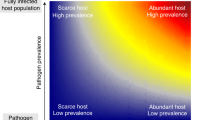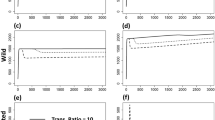Abstract
Classic infectious disease theory assumes that transmission depends on either the global density of the parasite (for directly transmitted diseases) or its global frequency (for sexually transmitted diseases). One important implication of this dichotomy is that parasite-driven host extinction is only predicted under frequency-dependent transmission. However, transmission is fundamentally a local process between individuals that is determined by their and/or their vector’s behaviour. We examine the implications of local transmission processes to the likelihood of disease-driven host extinction. Local density-dependent transmission can lead to parasite-driven extinction, but extinction is more likely under local frequency-dependent transmission and much more likely when there is active local searching behaviour. Density-dependent directly transmitted diseases spread locally can therefore lead to deterministic host extinction, but locally frequency-dependent passive vector-borne diseases are more likely to cause extinctions. However, it is active searching behaviour either by a vector or between sexual partners that is most likely to cause the host to go extinct. Our work emphasises that local processes are essential in determining parasite-driven extinctions, and the role of parasites in the extinction of rare species may have been underplayed due to the classic assumption of global density-dependent transmission.




Similar content being viewed by others
References
Anderson RM, May RM (1979) Population biology of infectious diseases: part I. Nature 280:361–367
Anderson RM (1981) Population dynamics of indirectly transmitted disease agents: the vector component. In: McKelvey JJ Jr, Eldridge BF, Maramorosch K (eds) Vectors of Disease Agents. Praeger, NY, pp 13–43
Antonovics J (2009) The effect of sterilizing diseases on host abundance and distribution along environmental gradients. Proc R Soc Lond B Biol Sci 276:1443–1448
Antonovics J, Iwasa Y, Hassell MP (1995) A generalized model of parasitoid, venereal, and vector-based transmission processes. Am Nat 145:661–675
Baudoin M (1975) Host castration as a parasitic strategy. Evolution 29:335–352
Boots M, Begon M (1994) Resource limitation and the lethal and sub-lethal effects of a viral pathogen in the Indian meal moth, Plodia interpunctella. Ecol Entomol 19:319–326
Boots M, Sasaki A (1999) ‘Small worlds’ and the evolution of virulence: infection occurs locally and at a distance. Proc R Soc Lond B Biol Sci 266:1933–1938
Boots M, Sasaki A (2000) The evolutionary dynamics of local infection and global reproduction in host-parasite interactions. Ecol Lett 3:181–185
Boots M, Sasaki A (2002) Parasite-driven extinction in spatially explicit host-parasite systems. Am Nat 159:706–713
Boots M (2004) Modelling insect diseases as functional predators. Physiol Entomol 29:237–239
Bremermann HJ, Pickering J (1983) A game-theoretical model of parasite virulence. J Theor Biol 100(3):411–426
Bremermann HJ, Thieme H (1989) A competitive exclusion principle for pathogen virulence. J Math Biol 27:179–190
Cavalli-Sforza LL (1958) Some data on the genetic structure of human populations. Proc 10th Int Cong Genet 1:389–407
Clay K (1991) Parasitic castration of plants by fungi. Trends Ecol Evol 6:162–166
Dieckmann, U., Law, R. and Metz, J. A. J. (2000). The geometry of ecological interactions: simplifying spatial complexity. Cambridge University Press
Doedel, E.J., Champneys, A.R., Fairgrieve, T.R., Kuznetsov,Y.A., Sandstede, B.,Wang, X.J. (1997). AUTO 97: Continuation and bifurcation software for ordinary differential equations. Available from http://indy.cs.concordia.ca/auto/. Accessed 18 Jan 2010
Getz WM, Pickering J (1983) Epidemic models: thresholds and population regulation. Am Nat 121(6):892–898
Hassell MP (1978) The dynamics of arthropod predator–prey systems. Princeton University Press, Princeton
Hassell, M. P. (2000). The Spatial and Temporal Dynamics of Host-Parasitoid Interactions. Oxford University Press.
Jaenike J (1992) Mycophagous Drosophila and their nematode parasites. Am Nat 139:893–906
Keeling MJ (1999) The effects of local spatial structure on epidemiological invasions. Proc R Soc Lond B Biol Sci 266:859–867
Kermack WO, McKendrick AG (1927) Contributions to the mathematical theory of epidemics-1. Proc R Soc Lond B Biol Sci 115A:700–721
Kuris AM (1974) Trophic interactions: similarity of parasitic castrators to parasitoids. Q Rev Biol 49:129–148
Lafferty KD, Kuris AM (1996) Biological control of marine pests. Ecology 77:1989–2000
Lafferty KD, Kuris AM (2009) Parasitic castration: the evolution and ecology of body snatchers. Trends Parasitol 25:564–572
Levin S, Pimental D (1981) Selection of intermediate rates of increase in parasite-host systems. Am Nat 117(3):308–315
Lockhart AB, Thrall PH, Antonovics J (1996) The distribution and characteristics of sexually transmitted diseases in animals: ecological and evolutionary implications. Biol Rev Camb Philos Soc 71:415–471
Matsuda H, Ogita N, Sasaki A, Sato K (1992) Statistical mechanics of population: the lattice Lotka-Volterra model. Prog Theor Phys 88(6):1035–1044
May RM, Anderson RM (1979) Population biology of infectious diseases: part II. Nature 280:455–461
McCallum H, Dobson A (1995) Detecting disease and parasite threats to endangered species and ecosystems. Trends Ecol Evol 10:190–194
Meyers LA, Pourbohloul B, Newman MEJ, Skowronski DM, Brunham RC (2005) Network theory and SARS: predicting outbreak diversity. J Theor Biol 232:71–81
Ovaskainen O, Cornell SJ (2006) Space and stochasticity in population dynamics. PNAS 103:12781–12786
Pedersen AB, Jones KE, Nunn CL, Altizer S (2007) Infectious diseases and extinction risk in wild mammals. Conserv Biol 21:1269–1279
Rand DA, Keeling M, Wilson HB (1995) Invasion, stability and evolution to criticality in spatially extended, artificial host-pathogen ecologies. Proc R Soc Lond B Biol Sci 259:55–63
Roy M, Pascual M (2006) On representing network heterogeneities in the incidence rate of simple epidemic models. Ecol Complex 3:80–90
Rudolf VHW, Antonovics J (2005) Species coexistence and pathogens with frequency-dependent transmission. Am Nat 166:112–118
Ryder JJ, Miller MR, White A, Knell RJ, Boots M (2007) Host-parasite population dynamics under combined frequency- and density-dependent transmission. Oikos 116:2017–2026
Sato K, Matsuda H, Sasaki A (1994) Pathogen invasion and host extinction in lattice structured populations. J Math Biol 32:251–268
Turner J, Begon M, Bowers RG (2003) Modelling pathogen transmission: the interrelationship between local and global approaches. Proc R Soc Lond B Biol Sci 270:105–112
Webb SD, Keeling MJ, Boots M (2007a) Host-parasite interactions between the local and the mean-field: how and when does spatial population structure matter? J Theor Biol 249:140–152
Webb SD, Keeling MJ, Boots M (2007b) Spatially extended host-parasite interactions: The role of recovery and immunity. Theor Popul Biol 71:251–266
Wennstrom A, Ericson L (2003) The concept of sexually transmitted diseases in plants: definition and applicability. Oikos 100:397–402
White A, Begon M, Bowers R (1999) The spread of infection in seasonal insect-pathogen systems. Oikos 85:487–498
Author information
Authors and Affiliations
Corresponding author
Electronic supplementary material
Below is the link to the electronic supplementary material.
ESM 1
(PDF 101 kb)
Rights and permissions
About this article
Cite this article
Best, A., Webb, S., Antonovics, J. et al. Local transmission processes and disease-driven host extinctions. Theor Ecol 5, 211–217 (2012). https://doi.org/10.1007/s12080-011-0111-7
Received:
Accepted:
Published:
Issue Date:
DOI: https://doi.org/10.1007/s12080-011-0111-7




